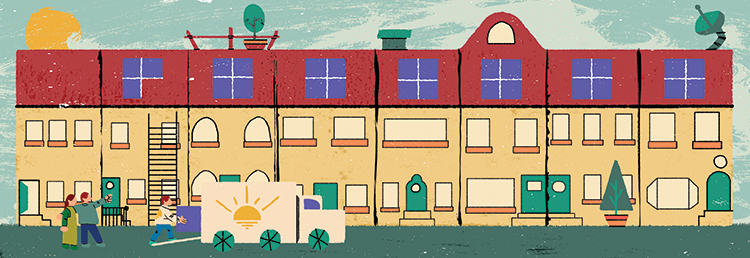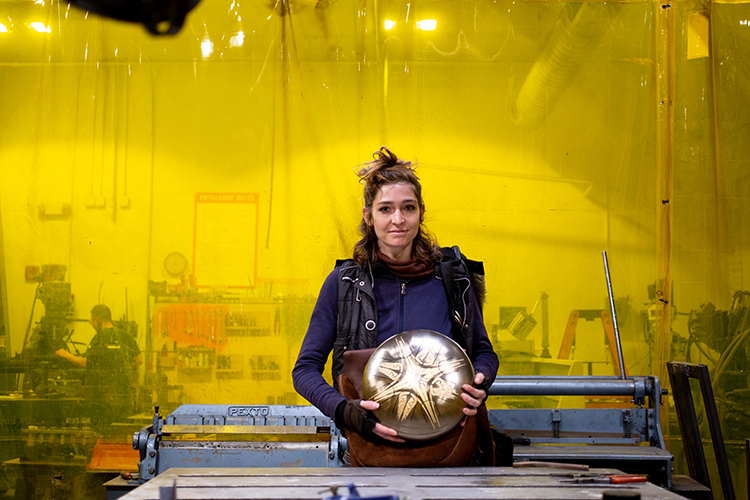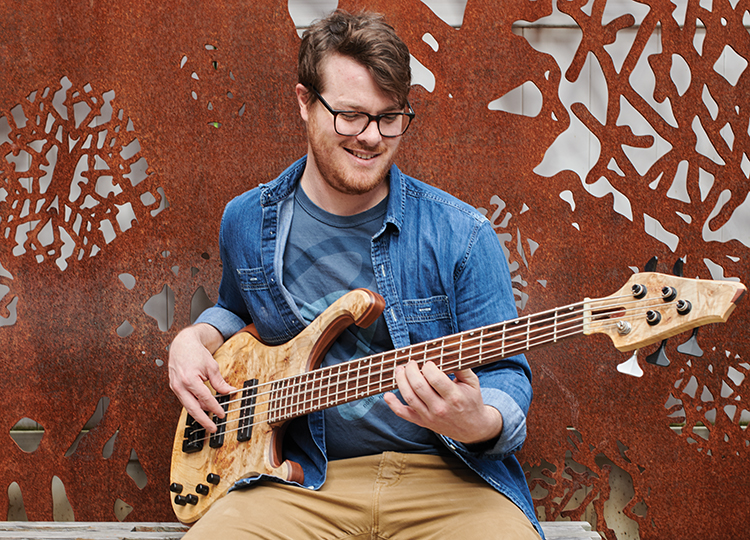by Alexandra W. Jones
Visible from the sidewalk, 12 shiny black solar panels accessorize the roof of Marion Storey Biddle’s purple home in Mount Airy. She smiles at the sight—her own independent power source.
There are more panels in the back, she says. She speaks excitedly about how much power the panels generate and the little changes her household has subsequently made, like switching over to an electric water heater and purchasing an electric car, all in the name of energy efficiency.
Biddle was one of a dozen homeowners that participated in the first round of the Northwest Philly Solar Co-op. The organization negotiated with solar providers to get a reduced rate.
Prior to committing, Biddle says that she—and most of people in her co-op—talked to others who had taken the plunge.
“Making sure that it works, it’s reliable, that kind of thing,” she explains.
She says that one neighbor who had a solar array installed a year before received so many phone calls, he joked he was a celebrity.
Since the panels on her home were installed in August 2017, Biddle has been impressed. She has since become a board member of the solar co-op, and strives to provide insight and advice to curious neighbors.
She tells them that, while it might take her a decade or so to pay her system off, she feels much happier subsisting on the power that her house generates, rather than energy from the electric company.
Biddle says she also shows these neighbors the monitoring system she uses to study her energy usage. She pulls up a program called SolarEdge and begins to discuss peaks in a bar graph that show her energy use throughout the day.
“This is turning the electric kettle on,” she says, pointing to an early morning blip. Another jump marks her turning on the space heater. When the graph shows steady electric use overnight, that means she was charging her electric car.
Neighbors often wonder if solar panels will cover all their electric costs, and for Biddle, they have. Biddle’s household produces just slightly more power than it uses each month.
“Our electric bill right now is zero,” she says.
Where there’s one, there’s many
According to Micah Gold-Markel, founder of local installation company Solar States, customers often seek advice from solar-powered neighbors before installing systems of their own.
“Nobody wants to be the first, but everybody’s heard about it,” he says. “When their neighbor does it, it lets people know: This is real.”
Dara Bortman, co-founder of Exact Solar, cites the importance of referrals, which often come from neighbors.
According to Bortman, people who install solar arrays feel like it’s such a no-brainer that everyone should do it. It’s something good for the environment, she says, and participants enjoy not only being able to monitor their personal power production from their phones, but making a little cash by selling their excess power back to energy companies.
“It’s really just the excitement about this new part of their life—not having an electric bill anymore and having this solar power plant on their roofs,” Bortman explains.
A map of Solar States’ installments around Philadelphia shows clusters of nearby installations, with many on the same street or block. The biggest aggregates are in neighborhoods like Spruce Hill, Bella Vista and Northern Liberties, where more than 30 installations have popped up just a few blocks apart. Smaller groups of 11 and 12, respectively, appear in Center City and Kensington.
These data points represent a trend that researchers commonly find with solar, wherein installations spread through neighborhoods in a wave-like pattern.
“There is the so-called ‘Keeping Up With the Joneses’ effect,” professor Marcello Graziano explains.
While working on his doctorate at the University of Connecticut, Graziano, who now works at Central Michigan University, teamed up with Yale professor Ken Gillingham. Together, in a project funded by the U.S. Department of Energy, they researched the spread of solar power across the state of Connecticut, seeking to find the most likely predictor of installations.
What they found was that one adoption in an area could lead to many, spreading out from the original as far as four miles. Solar took hold in a few neighborhoods in 2005 when the state began incentivizing it with subsidies, and in a “wave-like centrifugal pattern,” the installations spread from there.
In this study, Gillingham says they saw very clear patterns of solar adoptions throughout Connecticut, explained only partially by neighborhoods’ income levels and housing densities.
“Those are smaller factors,” Gillingham says, “but one of the more dominant forces is whether there are other solar adoptions already in that area.”
Similar conclusions have been drawn studying Austin, Texas, and various areas in California.
Philadelphia resident Mo Lareef decided to put panels on his own home in January 2016 after seeing a solar installation on his neighbor Dennis McOwen’s house across the street.
“Sometimes you need to see something to do something,” he says.
It was eye-opening for Lareef to see solar up close. He and McOwen talked about how it was a good investment, as well as the differences between leasing panels and buying them. Ultimately, Lareef had 40 panels installed on his home.
Each panel cost him roughly $1,200. But installers get a 30 percent federal tax credit for money they put toward installations, an incentive that reduced his overhead cost from $48,000 to $33,600. This tax credit expires at the end of 2019.
McOwen likewise installed solar after talking to someone else who had.
“I really got bit by the solar bug when I visited my brother, who has a farm,” he says.
His brother’s panels were on the ground, waist-high.
“I never thought about it until he started talking about it,” McOwen continues. He did his homework, and ultimately decided he would rather own panels than lease them. He put 47 315-watt panels on his home, and his garage, too.
“Both sides,” McOwen says. “I wanted to catch the sun coming up as much as possible, and then setting.”
The panels were installed in just over a week. He paid $47,000 up front. At a minimum, McOwen estimates he’s probably saving $4,000 of usage every year.
“It’s been three, going on four years,” he says. “I have nev
er had to pay a single cent to PECO.”
People talk to McOwen about it all the time. He’s in a housing development that has 89 homes.
“There’s probably about 15 or 20 of them that have become solarized,” he guesses.
On the rise
Bortman speculates that there may be a few factors that have contributed to the spread of solar: yard signs, calls from signs, solar company employees knocking on doors in neighborhoods with good roofs. And, perhaps, simple observation.
“All the time, people say they saw their neighbor went solar and that they started doing research themselves,” Bortman says.
Another study Gillingham conducted found that if panels are visible to neighbors from the street, rather than hidden on the top or on the backside of a neighbor’s roof, the spreadability of solar is enhanced because neighbors are more likely to talk to each other.
In Philadelphia, the number of solar permits has increased drastically over the last few years. Within the state’s Licenses and Inspection data, there’s a notable jump in people applying for solar permits: from just 12 applications in 2014 to 447 in 2018. This increase may be in large part due to Solarize Philly, a program that began in 2017, which offers Philadelphia residents group rates on solar installations through the Philadelphia Energy Authority.
“We’re able to leverage the group buying power by getting people to go solar at the same time the installers are willing to offer lower prices,” says Laura Rigell, the authority’s solar manager. “People typically [pay] around $2,000 below market rate.”
In 2017, Philadelphia was ranked the fourth fastest-growing solar energy market in the United States.
“It’s been booming,” Rigell says.
Campaigns like Solarize that get one household to install can have a spillover effect and lead to other household installations in the same area.
“We do know that people who hear about it by word of mouth are more likely to sign,” Rigell says.
The Solarize program, which began looking for 2019 installation candidates in April, is trying to figure out how it can utilize word-of-mouth referrals this summer, she continues.
They want to scale up the program.
Obstacles to overcome
Solar is not the only new technology that spreads out in waves, Gillingham confirms. Expansion could be the case for any new technology—in fact, similar results have been found in studies observing the spread of electric cars.
However, there are reasons why clusters might not pop up in every neighborhood for solar. For instance, in neighborhoods with higher housing density, like those in which rowhomes are common, there are typically fewer clusters because the houses are older and refurbishments must be done to ensure buildings are up to code for installations.
Finances may also play a role.
“Typically low-income houses have not been able to go solar in Philadelphia,” Rigell says. “Most people who participate in installing solar in Philly are definitely higher-income.”
While in Connecticut, where Gillingham and Graziano conducted their study, income was not a primary factor, Rigell is skeptical that this is also the case in Philadelphia, where comparable research has yet to be done on solar spreading. According to Rigell’s observations, most installers are making more than $41,500, the city’s median income.
And, of course, in areas where there are more renters, solar clusters appear fewer and farther between. This is because renters may not have the ability to put solar panels on the roof—the owner has to do so, creating a split incentive. The renter is paying for the electricity, so the owner would not directly benefit from the investment.
However, Rigell has spoken to a few landlords who have come up with a solution.
“There is a scenario where you can make it work,” she says. Some have increased their rent to compensate for the installation costs. Others still charge tenants for electricity, buying it now directly from their landlords.










